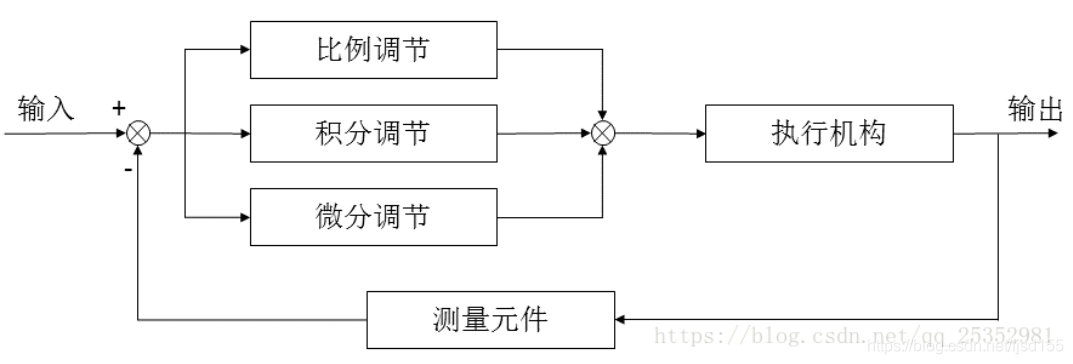单片机程序设计实验:PID控制与算法实现,深入解析单片机控制系统的精髓
发布时间: 2024-07-07 13:58:10 阅读量: 63 订阅数: 27 


PID算法,适合于单片机的控制

# 1. PID控制理论基础**
PID控制是一种广泛应用于工业自动化和过程控制中的反馈控制算法。其基本原理是通过测量被控对象的输出,与期望值进行比较,并根据偏差计算出控制量,从而实现对被控对象的控制。
PID算法的数学模型为:
```
u(t) = Kp * e(t) + Ki * ∫e(t)dt + Kd * de(t)/dt
```
其中:
* u(t) 为控制量
* e(t) 为偏差(期望值 - 输出值)
* Kp 为比例增益
* Ki 为积分增益
* Kd 为微分增益
# 2. 单片机PID控制算法实现
### 2.1 PID算法原理与参数设定
#### 2.1.1 PID算法的数学模型
PID算法(比例-积分-微分算法)是一种经典的反馈控制算法,其数学模型如下:
```
u(t) = Kp * e(t) + Ki * ∫e(t)dt + Kd * de(t)/dt
```
其中:
- `u(t)`:控制输出
- `e(t)`:误差,即设定值与实际值之差
- `Kp`:比例增益
- `Ki`:积分增益
- `Kd`:微分增益
**参数说明:**
- `Kp`:控制输出与误差成正比,增大`Kp`可提高控制精度,但过大会导致系统不稳定。
- `Ki`:控制输出与误差的积分成正比,增大`Ki`可消除稳态误差,但过大会导致系统响应缓慢。
- `Kd`:控制输出与误差的微分成正比,增大`Kd`可提高系统响应速度,但过大会导致系统振荡。
#### 2.1.2 PID参数的整定方法
PID参数的整定方法有多种,常见的有:
- **齐格勒-尼科尔斯法:**通过阶跃响应曲线确定参数。
- **继电器震荡法:**通过继电器开关来确定参数。
- **自整定法:**通过算法自动调整参数。
### 2.2 单片机PID算法程序设计
#### 2.2.1 程序流程设计
单片机PID算法程序流程图如下:
```mermaid
graph LR
subgraph 程序流程
read_input[读取输入] --> calculate_error[计算误差]
calculate_error --> calculate_output[计算输出]
calculate_output --> write_output[写入输出]
end
```
**流程说明:**
1. 读取输入:读取传感器采集的实际值。
2. 计算误差:计算设定值与实际值之差。
3. 计算输出:根据PID算法计算控制输出。
4. 写入输出:将控制输出写入执行器。
#### 2.2.2 数据采集与处理
数据采集模块负责从传感器获取实际值。处理模块对实际值进行滤波、校准等处理,以提高控制精度。
```c
// 数据采集与处理
uint16_t adc_value;
void data_acquisition() {
// 读取ADC值
adc_value = read_adc();
// 滤波处理
adc_value = adc_filter(adc_value);
// 校准处理
adc_value = adc_calibration(adc_value);
}
```
**代码逻辑分析:**
- `read_adc()`函数读取ADC值。
- `adc_filter()`函数对ADC值进行滤波处理。
- `adc_calibration()`函数对ADC值进行校准处理。
#### 2.2.3 控制输出计算与执行
控制输出计算模块根据PID算法计算控制输出。执行模块将控制输出写入执行器。
```c
// 控制输出计算与执行
int16_t control_output;
void control_output_calculation() {
// 计算PID输出
control_output = pid_calculate(error, integral, derivative);
// 限制输出范围
control_output = limit_output(control_output);
// 写入执行器
write_actuator(control_output);
}
```
**代码逻辑分析:**
- `pid_calculate()`函数根据PID算法计算控制输出。
- `limit_output()`函数限制控制输出范围。
- `write_actuator()`函数将控制输出写入执行器。
# 3. 单片机PID控制实验实践
### 3.1 实验平台搭建与硬件配置
#### 3.1.1 单片机系统简介
单片机系统是基于单片机的微型计算机系统,具有体积小、功耗低、成本低等特点。单片机系统主要由单片机、存储器、输入/输出接口和电源等组成。
在单片机PID控制实验中,常用的单片机有51系列、STM32系列和Arduino系列等。这些单片机具有丰富的片上资源,如定时器、ADC、PWM等,可以方便地实现PID控制算法。
#### 3.1.2 传感器与执行器选型
传感器用于采集被控对象的实际输出值,执行器用于根据控制器的输出值驱动被控对象。在单片机PID控制实验中,常用的传感器有温度传感器、光传感器、位置传感器等。常用的执行器有电机、继电器、电磁阀等。
传感器的选型需要考虑被控对象的实际输出值范围、精度和响应时间等因素。执行器的选型需要考虑被控对象的控制要求、功率和响应时间等因素。
### 3.2 PID控制实验过程与数据分析
#### 3.2.1 实验步骤与操作
单片机PID控制实验步骤如下:
1. 搭建实验平台,包括单片机系统、传感器、执行器和被控对象。
2. 编写PID控制程序,包括数据采
0
0





